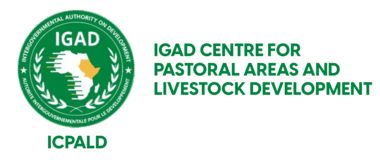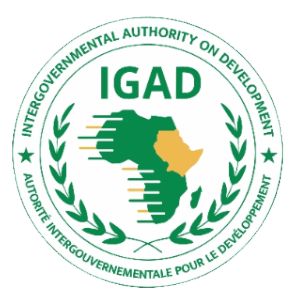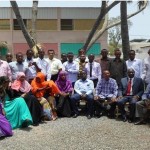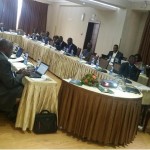The objective of the forum was to develop consensus regional climate outlook for the September to December 2015 rainfall season and to formulate mitigation strategies on the implications of the projected seasonal climate outlook on the critical socioeconomic sectors of the GHA region. The forum also provided a regional interaction platform for policy makers , climate scientists and other users of climate information from various sectors . A review of the lessons /experiences from the use of products provided in the last regional climate outlook forum was also conducted
The forecast for September- December was released.
The forecast indicates that there is a likelihood of enhanced rainfall around the equatorial region of the GHA as shown in figures 1 & 2 below. This is as a result of the el Niño phenomenon in the pacific and the positive Indian Ocean Dipole (IOD). The analogue years for this season are shown in Figure 3
Figure 1: SOND GHA Forecast
Figure 2: SOND 2015 forecast in amounts
Analogue Years
Figure 3: Analogue years for the SOND 2015 forecast
The livestock sector participants later and discussed the likely impacts of the forecast on the sector and gave recommendations and the way forward as detailed below.
Expected impacts of the forecast for the green zone ( expected enhanced rainfall)
ETHIOPIA
Shebelle valley- flooding
- Monitoring for vectors although RVF is not endemic but at high risk
- Oromia & Ogaden , Gambela & Asosa region– pastoral community
- Lumpy skin disease due to flooding and increase in vector numbers
- Inaccessibility of areas due to swamping
- FMD
SOMALIA
- Shabelle –Juba valley & coastal zone
- Risk of flooding
- Increased risk of RVF
- Flooded pastures
- Tick-borne diseases
- Respiratory diseases in the small ruminants and poultry
- Key markets likely to be impacted are Jezira, Garissa, Bosaso, Babera
- Risk of flooding
TANZANIA
- Kagera, Shinyanga, Tabora , Lake zone, North of Arusha
- Potential RVF outbreak
- Tick-borne diseases eg ECF
UGANDA
- West Nile, South of Mbale to Uganda-Rwanda border
- Respiratory diseases in the small ruminants and poultry
- Low production
- African swine fever
- Foot rot
- Tick-borne diseases increase
- Black quarter and anthrax
KENYA
- North Eastern, Central & Western Kenya
- Risk of flooding
- Increased risk of RVF
- Flooded pastures
- Tick-borne diseases
- Respiratory diseases in the small ruminants and poultry
- Risk of flooding
SOUTH SUDAN
- Eastern and Central Equatorial region
- Tick-borne diseases
- Risk assessment for RVF (only risk)
Socio-economic factors that may exacerbate the situation
- Poor road infrastructure – constraint to extension services and marketing
- Limit access to veterinary services
- Limited market access
- On-going conflict in Southern Sudan and Somalia
Mitigation
- Coordination of line ministries in contingency planning
- Targeted vaccination of livestock in the high risk RVF areas
- Increased surveillance of RVF (vector and disease) especially in Kenya and Tanzania and Somalia (all analogue years had RVF outbreaks)
- Vector control
- De-worming of livestock
- Negotiation for access to higher grounds
- Re-seeding of rangelands particularly in counties that have been in poor conditions eg. Wajir
- Range regeneration
- Water harvesting should be encouraged
Expected impacts of the forecast for Zone 3 and 5 (CYAN- expected Normal to above normal rainfall )
TANZANIA
- Part of Singida, Dodoma, Kilimanjaro, Arusha, Manyara
- Water and pasture availability is threatened, Likely livestock movements into the national parks leading to conflict
UGANDA
- Karamoja is in crisis but if they receive normal to AN then pasture may regenerate
KENYA
- Turkana; situation is normal. Normal Rf may promote pasture regeneration
- Southern rangelands and coastal strip ; the situation is likely to be good
Mitigation measures
- Continuous monitoring of pastures and rainfall performance
- De-worming of livestock
Expected impacts of the forecast for Zone 2 (yellow zone- expected Normal to below normal rainfall )
ETHIOPIA
- Amhara region(oil seeds), parts of Oromia , Tigray, Somali and Afar region (livestock)
- Livestock deaths already reported. If it receives BN rainfall the situation requires special attention
SUDAN
- Already in crisis state
SOMALILAND
- Situation may worsen
SOUTH SUDAN
- Unity state, upper Nile.
- Poor pastures likely
Expected impacts of the forecast for Zone 1 and 6 ( Grey Zone- expected climatology )
SUDAN
- Already crisis state
ETHIOPIA
- Tigray , Afar and parts of Somali region, Shinile zone
- Both MAM and JJA were below normal
- Situation is bad
TANZANIA
- Less livestock population so pastures not a big issue
DJIBOUTI
- Already in crisis state because of the failed last 2 seasons
Mitigation measures
- Provision of feeds for animals in crisis zones
- Commercial de-stocking (grey/yellow zones)
General recommendations
- What are the temperature projections for the region?
- it would be important for ICPAC to also give temperature projections for the same season . This will be important in movements of vectors and disease spread in animals and humans
- Likelihood of further degradation of the rangelands especially in Zone 3 areas that will receive high rainfall and the already dry areas that may face further overgrazing.
- Rangeland rehabilitation efforts should be intensified/ initiated
Next steps
- The above out puts will be shared on Livestock & Pastoralism working group and ICPALD web site
- The recommendations on control of RFV from the April 2015 international meeting is being shared and we will continue to share for various stakeholders including policy makers






